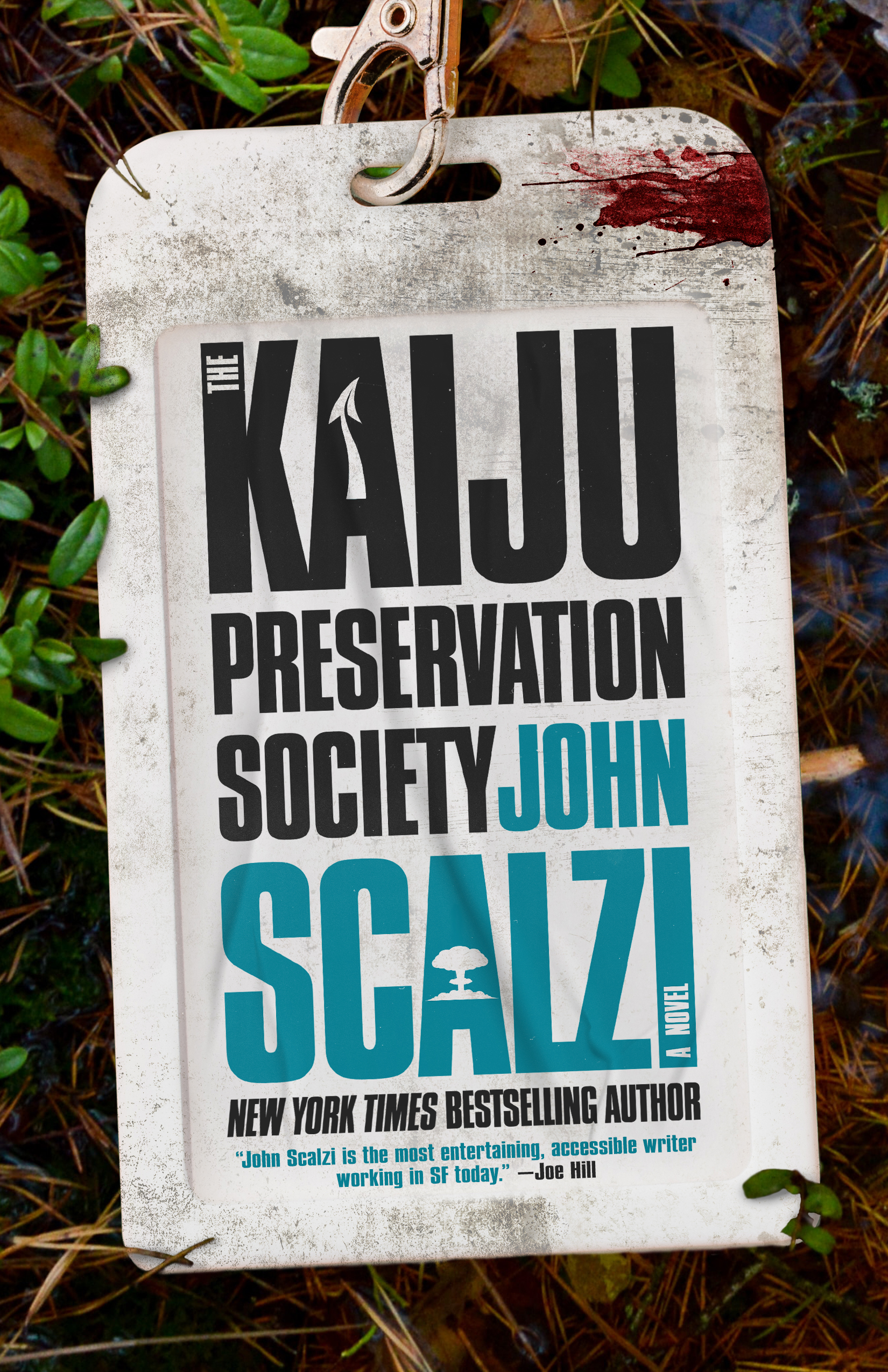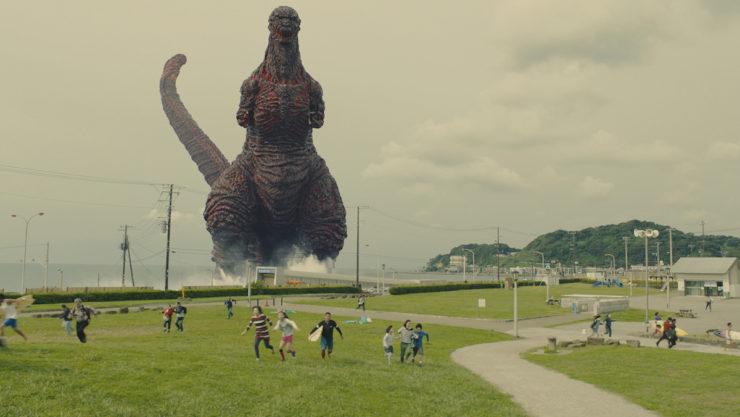I am unabashed in proclaiming that Shin Godzilla (2016) is downright majestic. The production values are great, and the film is a thrill from first second to last. The special effects are some of the best of the franchise, and that includes the recent mega-budgeted, CG-besotted American versions.
That’s not what I’m here to talk to you about.
When you look at it from its high-concept synopsis, Shin Godzilla is nothing radical: Mysterious disturbance in Tokyo Bay; followed by initial rampage through the city; followed by an abrupt exit and brief respite; followed by a return, bigger, badder, and now armed with nuclear breath. Conventional weapons are useless; a nuclear strike is ominously threatened; only the harnessed efforts of Japan’s greatest minds can defeat the blah blah blah.
It turns out that’s not a bug—it’s a feature.
You see, this particular iteration of the Godzilla legend has been written and directed by Hideaki Anno, a man who has logged most of his time working for the maverick anime studio Gainax, and whose most prominent credit is the controversial giant robot series Neon Genesis Evangelion. That show took another stock scenario—adolescents impressed into battle against giant, surreal monsters called Angels—and twisted it until it turned into a dark psychodrama about parental dysfunction, sexual frustration, and theological apocalypse.
There may not be any daddy issues in Shin Godzilla, but that doesn’t mean Anno is sublimating his tendency to put a skew on a time-worn narrative. Our first glimpse of Godzilla is not as fearsome, bipedal lizard, but as a kind-of googly-eyed, four legged—albeit still hideously destructive—tadpole. The U.S. is represented largely in the person of the politically savvy Japanese-American envoy Kayoko Ann Patterson (Satomi Ishihara), who harbors presidential ambitions and speaks Japanese better than she does English. And the hallowed brain trust that comes to Japan’s rescue is actually a roomful of nerds, geeks, and dweebs, a collection of misfits who are not reluctant to proclaim breakthroughs by running hysterically around their command center while clutching their laptops.
And then there are the subtitles. Oh God, are there subtitles. Or supertitles, actually, since while the bottom of the screen is occupied with the traditional English translations of dialogue, the top feeds us a steady stream of clarifying info. It would be an exaggeration to say that every other shot gets tagged, but not by much—you get names and titles of officials, identifiers for the numerous city wards, even the types of ordinance being hurled at the big lizard. I swear there was one shot labelled, “Swingline Stapler—Mfg. June 20, 2009,” but that may have been my imagination.
The overkill is weird, but not, I think, an accident. By and large, Anno’s mise-en-scène takes a step back from the expected polish of a tentpole blockbuster to render the story in a more documentary style. Yet even there, the iconoclastic director can’t resist taking the piss out of that typically sober format. Hence the obsessive labelling, the weird narrative leaps—one sequence has a meeting of officials interrupted by a title card indicating that some footage has been excised for time’s sake—and some very Evangelion-ish editing to intercut a dispassionate conference room discussion with quick-cut glimpses of the monster wreaking havoc.
But the fly-on-the-wall presentation is more than just a superficial style choice. It’s key to the film’s main thesis, one that connects this installment not just to the giant lizard’s original genesis in the aftermath of Hiroshima and Nagasaki—here resurrected when the film’s officials wrestle with the knowledge that their failure to subdue the monster will trigger an American nuclear strike—but also to a not-dissimilar dark spot in recent Japanese history.
On March 11, 2011, an earthquake and tsunami caused a chain of failures at the Fukushima Daiichi Nuclear Power Plant, leading to meltdowns, explosions, and the release of radioactive contamination. Evacuations were ordered, dislocating some 154,000 residents, and analysis indicates that it will take from thirty to forty years to decontaminate the area. In the years that followed, it was determined that the disaster happened as much by bureaucratic failure as technical breakdown. TEPCO, the company operating the plant, had been lax in establishing safety protocols; the government agency in charge suffered a conflict of interest between promoting nuclear power and overseeing the industry; and poor communication and inadequate government response plagued the event both during and after the calamity.
For all the ways that Anno has chosen to ground Shin Godzilla in reality, the most compelling may be how the Fukushima shit show informs the narrative. The film’s entire approach—the incessant titling, the realistic effects, the anxious international politics—seems to turn on one main question: What if an actual bureaucracy had to deal with a giant monster attack?
The answer comes in Shin Godzilla’s emphasis on officials struggling to cope with unimagined catastrophe. A fair amount of the film’s runtime is given to functionaries gathering around conference tables and huddling in offices, passing around documents and examining PowerPoint displays. There are the typical chain-of-command confusions—at one point, low-level official and main protagonist Rando Yaguchi (Hiroki Hasegawa) begins to assert his authority, only to have another colleague bluntly ask to whom he’s issuing orders. And the tendency toward inertia within a large organization continually arises—when the monster’s initial disturbance in Tokyo Bay dies down, one official is eager to declare the crisis over; later, another official, working off bad advice, goes before the cameras to insist that Godzilla couldn’t survive out of the water, just as the monster makes landfall. There are arguments about whether the creature should be destroyed, driven away, or captured (for science!), and damage reports focus on the monster’s noxious, radioactive secretions and the resulting risk of contamination. Further muddying the organizational waters is the intervention of world governments (the U.S. in particular), who seek to have a say in Japan’s response, some for perhaps shady motives.
Buy the Book


The Kaiju Preservation Society
So immersed is the film in the ethos of big government that midway through, as Godzilla has razed buildings, downed aircraft and exterminated the Prime Minister and his entourage, Yaguchi huddles with his friend and party deputy chairman (Satoru Matsuo) to discuss how this situation might better position him for his own run as P.M. Oddly, in context, the moment feels perfectly natural, just two politicians doing what they do best: Assessing a situation and determining how it can be used to advance their careers.
The curious thing is, unlike in Evangelion where the protagonists struggled against a literally faceless bureaucracy, and in counterpoint to the organizational nightmare that was Fukushima, here the system actually works. The political hack eventually impressed into the role of Prime Minister may be in over his head, but he’s aware of his shortcomings and knows enough to let the people with a better handle on the situation take charge. Despite Yaguchi being warned by a senior aide to keep his head down and fall in line, he asserts himself frequently, and it’s ultimately his nerd squad who uncovers a way to defeat Godzilla and avoid nuclear holocaust. And just generally, underneath the seeming noise and chaos of different departments pursuing their own agendas for their own interests, an almost organic consensus forms, steering the whole messy operation toward a beneficial end.
In 1985, after much internal wrangling, Terry Gilliam’s masterful Brazil debuted. That dystopian comedy’s key premise was that fascism arose not just through the efforts of a clutch of strongmen, but through the conscious neglect of a vast bureaucracy, each participant keeping their heads down and going on with their assigned tasks, never bothering to step back and see the terror of which they were a component part. Hideaki Anno’s Shin Godzilla presents a counterargument, in which the tunnel vision of bureaucrats is in-and-of-itself neither good nor evil, and any outcome can turn on the wills of the many, many human cogs that make the machinery of government run. It can lead to the devastation of a nuclear plant disaster, or the vanquishment of an impossible, stories-tall lizard.
Part of Shin Godzilla’s positive outlook may be specific to Japan—in a culture that tends to value conformity over individuality, it would be natural to think that the outcome of cooperative effort would tend toward positive results (although at one point Yaguchi reminds a colleague about how mass delusion led to ruination for the country in WWII). But this also may just be Hideaki Anno once more indulging his sardonic side, measuring the idealism of movie make-believe—where cooperation and teamwork can save a civilization—against a chaotic reality where, through greed and ineptitude, nuclear devastation is an all-too-likely probability. Maybe, in the end, the lesson to be learned is that any large system cannot function as a mindless entity. We need to be aware not just of who we put in charge of steering the ship, but also our own culpability in making sure the craft isn’t being driven into an iceberg.
* * *
IMHO, there are two, truly great Godzilla films: 1954’s Gojira (the original Japanese version, not the American release with Raymond Burr edited in as wild-n-crazy journalist Steve Martin), and Shin Godzilla. But maybe you don’t feel that way. Maybe you feel the monster was better showcased in another outing (although anyone bringing up Godzilla’s Revenge had better have a *damn* good reason). Or maybe you feel there’s another monster that deserves to take the crown of ultimate kaiju. Whatever you think, we have a comments section below that’s open and waiting for your input. Just remember, this is Tor.com, not Tokyo. We do not stomp and torch here, we discuss and consider. Let’s be friends, and get to conversing…
Dan Persons has been knocking about the genre media beat for, oh, a good handful of years, now. He’s presently house critic for the radio show Hour of the Wolf on WBAI 99.5FM in New York, and previously was editor of Cinefantastique and Animefantastique, as well as producer of news updates for The Monster Channel. He is also founder of Anime Philadelphia, a program to encourage theatrical screenings of Japanese animation. And you should taste his One Alarm Chili! Wow!










